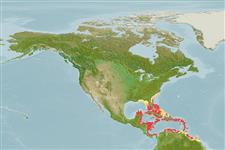>
Clupeiformes (Herrings) >
Dorosomatidae (Gizzard shads and sardinellas)
Etymology: Harengula: Old English haring, hering = mackerel, the fish Clupea harengus (Ref. 45335).
More on author: Cuvier.
Environment: milieu / climate zone / depth range / distribution range
Ekologi
laut berasosiasi dengan karang; kisaran kedalaman 0 - 50 m (Ref. 188). Subtropical; 34°N - 4°N, 90°W - 52°W (Ref. 188)
Western Atlantic: Bermuda, Florida (USA), Bahamas, Caribbean, Guianas (but no records to the south of this; no Brazilian specimens in the extensive collections of the Museu de Zoologia, Sao Paulo, Brazil).
Length at first maturity / Size / Weight / umur
Maturity: Lm 11.0, range 9 - ? cm
Max length : 22.0 cm TL jantan/; (Ref. 26340); common length : 15.0 cm TL jantan/; (Ref. 5217)
Duri punggung (Keseluruhan (total)): 0; duri punggung lunak (Keseluruhan (total)): 13-21; Duri dubur 0; Sirip dubur lunak: 12 - 23. Tooth plate on tongue and tooth plate behind it (basihyal and basibranchial tooth plates) very narrow, their width about 10 times in combined length, the basihyal tooth plate not bulging in front. Scales thin, loosely attached, easily shed. Tips of anterior dorsal fin rays dark. Reddish or orange spot behind upper end of gill (Ref. 26938). Body slender, with evenly curved upper and lower profiles (Ref. 7251).
Occur in coastal waters, usually along the shoreline (Ref. 9710) and over clear coral reefs (Ref. 5217). May form large schools in beaches, mainly over Thalassia beds (Ref. 5217). Often in polluted areas (Ref. 9710).
Life cycle and mating behavior
Kematangan | Reproduksi, perkembang biakan | Pemijahan | telur-telur | Fecundity | Larva
Whitehead, P.J.P., 1985. FAO Species Catalogue. Vol. 7. Clupeoid fishes of the world (suborder Clupeoidei). An annotated and illustrated catalogue of the herrings, sardines, pilchards, sprats, shads, anchovies and wolf-herrings. FAO Fish. Synop. 125(7/1):1-303. Rome: FAO. (Ref. 188)
Status IUCN Red List (Ref. 130435)
penggunaan manusia
Perikanan: komersial; umpan: usually
informasi lanjut
AcuanBudidaya airprofil budidaya airStrainGenetikaElectrophoresesDiturunkanPenyakit-penyakitPengolahanNutrientsMass conversion
mitraGambarStamps, Coins Misc.Suara-suaraCiguateraKecepatanTipe renangArea insangOtolithsOtakPenglihatan / visi
Alat, peralatan
laporan khas
muat turun XML
Sumber internet
Estimates based on models
Preferred temperature (Ref.
123201): 24.5 - 28, mean 26.7 °C (based on 104 cells).
Phylogenetic diversity index (Ref.
82804): PD
50 = 0.5625 [Uniqueness, from 0.5 = low to 2.0 = high].
Bayesian length-weight: a=0.00977 (0.00606 - 0.01577), b=3.06 (2.93 - 3.19), in cm total length, based on LWR estimates for this species & (Sub)family-body (Ref.
93245).
Trophic level (Ref.
69278): 3.4 ±0.1 se; based on diet studies.
Generation time: 2.7 ( na - na) years. Estimated as median ln(3)/K based on 2
growth studies.
Daya lenting (Ref.
120179): Tinggi, Waktu penggandaan populasi minimum kurang dari 15 bulan (K=0.41-1.03; tm=1.5; Fec=41,000).
Fishing Vulnerability (Ref.
59153): Low vulnerability (14 of 100).
Nutrients (Ref.
124155): Calcium = 61.6 [28.5, 116.2] mg/100g; Iron = 1.07 [0.53, 1.98] mg/100g; Protein = 20 [19, 21] %; Omega3 = 0.348 [0.190, 0.650] g/100g; Selenium = 17.1 [8.4, 38.4] μg/100g; VitaminA = 53.8 [17.1, 175.0] μg/100g; Zinc = 0.913 [0.586, 1.427] mg/100g (wet weight);
